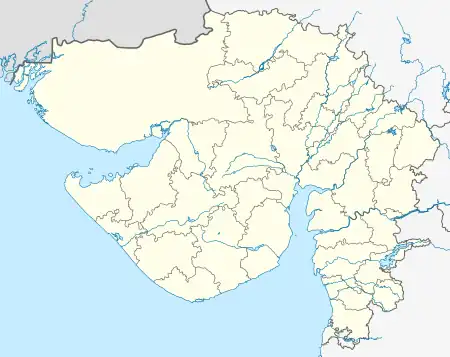Dhansura
Dhansura is a small town in the Aravalli district of Gujarat, India. The town is located about 85 km northeast of Ahmedabad. Previously it was a part of Sabarkantha district[1] and now it is part of Aravalli district.
Dhansura
Crusher City and plastic stretch film manufacture called Duraplast Industries | |
|---|---|
Town | |
 Dhansura Location in Gujarat, India  Dhansura Dhansura (India) | |
| Coordinates: 23°20′57″N 73°12′43″E | |
| Country | |
| State | Gujarat |
| District | Aravalli district |
| Government | |
| • Body | Dhansura Gram Panchayat |
| Population (2011) | |
| • Total | 12,424 |
| • Density | 328/km2 (850/sq mi) |
| Languages | |
| • Official | Gujarati, Hindi |
| Time zone | UTC+5:30 (IST) |
| PIN | 383310 |
| Telephone code | 2774 |
| Vehicle registration | GJ - 31 |
| Nearest city | Modasa |
| Sex ratio | 926 ♂/♀ |
| Literacy | 80.98%% |
| Lok Sabha constituency | Aravalli |
| Vidhan Sabha constituency | Modasa |
| Civic agency | Dhansura Gram Panchayat |
| Website | gujaratindia |
Dhansura is 16 km from Modasa on the Gujarat state highway 59 and is connected with Modasa by state transport services. It is an important trading centre with market yard, two oil-mills and five ginning and pressing factories. It is famous for its jaw crusher manufacturing industries. and well known plastic stretch film manufacture DURAPLAST INDUSTRIES is in dhansura, vabrating screen manufracture AMBICA ENGINEERING , saw mill business is there SHREE GANESH SAW MIL, There is a Panchayat ghar. There are hostels for students of Khadayata Banias, Kutchi Patels and Chaudhari Patels. There is a separate hostel for girls.
History
Around in 1982, B. J. Makwana of the Department of Archaeology of the Government of Gujarat and Suman H. Pandya of the DPCBL Mahila Arts and Commerce College, Dhansura undertook excavation at the mound known as Gormati-ni-Khan situated to the north of the village. During excavation, two human skeletons probably belonging to mesolithic period were unearthed from a depth of 105 cms which were oriented north-east to south-west. One of these was of an adult while the other was that of a child. Broken teeth of large animals, back-bones and other burnt bones, microlithic tools e.g., blade, lunates, point, flake, scraper made from chert, carnelian and chalcedony were also found.In one of the trenches human skeleton was found. In the same trench, below the skeleton a saddle quern found in association with charred bones of Bos indicus, hammerstones and microliths, etc.[2]
References
- Rasiklal Chhotalal Parikh; Gautama Vā Paṭela; Bharati Kirtikumar Shelat (2005). Rasika-bhāratī: Prof. R.C. Parikh Commemoration Volume. Gandhinagar: Sanskrit Sahitya Akademi. p. 389.
- Sandhya Bansal. Indian Archaeology 1989 90 A Review.